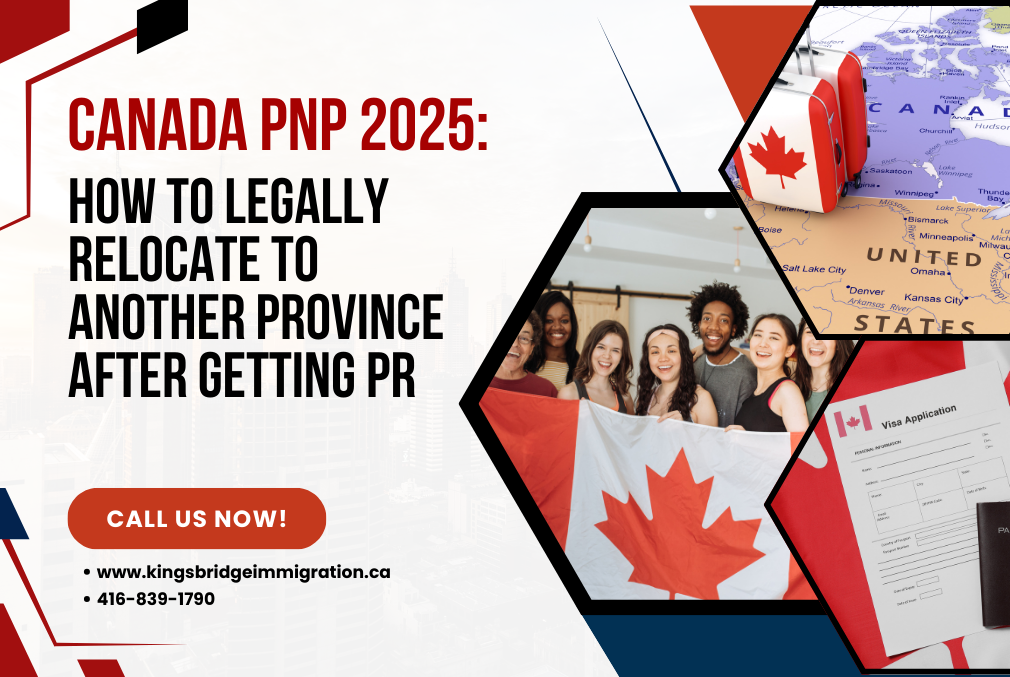
Canada’s Provincial Nominee Program (PNP) continues to play a crucial role in the country’s immigration system by allowing provinces and territories to select candidates who can support local economic and labor demands. However, relocating to a different province after receiving Permanent Resident (PR) status through a PNP pathway requires careful consideration, especially given the stricter rules and reduced nomination quotas in 2025.
What’s Changing in Canada’s PNP for 2025?
The PNP allows provinces (except Quebec and Nunavut) to nominate immigrants that align with their economic needs. In 2025, the federal government reduced the number of PNP spots to 55,000, down from 110,000 in 2024, due to revised immigration targets. This significant cut makes it more competitive to get a nomination, requiring applicants to apply strategically.
There are two types of PNP pathways:
• Enhanced (linked with Express Entry)
• Base (direct applications to provinces)
Applicants must show a genuine intention to settle in the nominating province, often by signing formal commitments.
Key Change in 2025:
Due to limited allocations, provinces are prioritizing critical sectors such as healthcare, construction, and tech. For instance, British Columbia’s PNP allotment dropped to 4,000, with a strong focus on health professionals and entrepreneurs.
Updated PNP Process for 2025
Step 1: Check Eligibility
Ensure you meet the criteria of the province and the relevant federal immigration program (e.g., FSW, CEC). Language requirements and proof of intent to settle are key.
Step 2: Apply for Nomination
Enhanced Streams: Create an Express Entry profile and await a provincial Notification of Interest (NOI).
Base Streams: Apply directly via the province’s website or intake system.
Step 3: Accept the Nomination
Enhanced nominees must accept within 30 days to get 600 CRS points. Base nominees proceed directly to PR application.
Step 4: Apply for PR
Express Entry applicants must apply within 60 days. Base stream applications may take 12–18 months via paper or portal submission.
Step 5: Land in the Nominating Province
Complete your landing and fulfill provincial requirements, such as New Brunswick’s in-person registration within 30 days.
Note for 2025:
Due to reduced quotas, some provinces are prioritizing applicants already living in Canada. Stay updated via official provincial sites.
Can You Relocate After Receiving PR Through PNP in 2025?
Yes, Canada’s Charter grants mobility rights, meaning PR holders can live and work anywhere. However, if it appears you never intended to settle in your nominating province, this could be considered misrepresentation.
Potential Risks Include:
- • Revocation of PR
- • Deportation
- • 5-year ban on re-entry
Some provinces, like BC and Ontario, monitor nominee compliance more closely in 2025.
How Long Should You Stay in the Province?
While no specific law dictates a minimum stay, remaining in your province for a reasonable time helps demonstrate good faith.
Recommended Timelines:
Short Stay (1-2 months): Risky, especially if you leave right after receiving your PR card.
Moderate Stay (6–12 months): Usually enough if you can’t secure employment or settle properly.
Longer Stay (1–2 years): Strong evidence of your intent to settle.
Key Factors:
- • Compliance with local obligations (e.g., NB registration)
- • Proof of effort to settle
- • Valid reasons for moving (e.g., job, family, medical needs)
Risks of Moving Too Quickly
Immediate relocation may trigger an investigation, particularly if:
- • You never obtained a health card, job, or lease in the nominating province
- • You began working or studying elsewhere immediately
Valid Reasons to Move After PNP PR
To reduce risk, ensure your relocation is supported by valid reasons:
- • Job opportunities unavailable in your province
- • Reuniting with family
- • Education or health-related needs
Always notify the province and document your situation before moving. For example, BC requires notice via voicemail or email.
How to Prove Your Intent to Settle
Build a strong case with supporting documents, including:
- • Lease or home purchase agreements
- • Utility bills and mail
- • Job applications and employment offers
- • Provincial ID (e.g., health card, driver’s license)
- • Community engagement (volunteering, etc.)
- • Email communications with the province
Retention: Keep these documents for at least 5 years.
2025 Province-Specific Updates
British Columbia:
4,000 nomination cap, healthcare and entrepreneur focus. Some student streams are paused.
Ontario:
Expanded job offer streams, including options for self-employed physicians. Tougher fraud prevention rules.
Alberta:
Focus on healthcare and law enforcement roles. Smaller draws due to federal cuts.
New Brunswick:
Requires in-person registration and prioritizes in-Canada applicants following 50% quota reduction.
Legal Steps to Relocate in 2025
- • Review provincial obligations (e.g., in-person registration).
- • Establish genuine ties (housing, employment, ID).
- • Collect evidence of efforts and valid reasons to move.
- • Notify the province in writing.
- • Update your address with IRCC and service providers.
- • Be prepared to show documentation if questioned.
Move Provinces Confidently and Legally in 2025
While relocating after receiving PR through the PNP is your right, doing so without proper preparation in 2025 could jeopardize your status due to stricter scrutiny and reduced quotas.
Stay at least 6–12 months, document your efforts to settle, and communicate your intent clearly to reduce risks.
For personalized support, speak with a Regulated Canadian Immigration Consultant (RCIC) or your province’s immigration office.